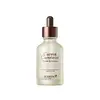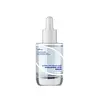What's inside
What's inside
 Key Ingredients
Key Ingredients

 Benefits
Benefits

 Concerns
Concerns

No concerns
 Ingredients Side-by-side
Ingredients Side-by-side

Daucus Carota Sativa Root Extract
Skin ConditioningGlycerin
HumectantPropanediol
SolventMethylpropanediol
SolventDipropylene Glycol
HumectantWater
Skin ConditioningButylene Glycol
HumectantDiethoxyethyl Succinate
SolventPPG-13-Decyltetradeceth-24
Emulsifying1,2-Hexanediol
Skin ConditioningBetaine
HumectantEthylhexylglycerin
Skin ConditioningPanthenol
Skin ConditioningUndaria Pinnatifida Extract
Skin ConditioningSodium Carbomer
Emulsion StabilisingC10-30 Alkyl Acrylate
Allantoin
Skin ConditioningCarbomer
Emulsion StabilisingSodium Hyaluronate
HumectantGlyceryl Acrylate/Acrylic Acid Copolymer
HumectantDaucus Carota Sativa Seed Oil
EmollientSodium Phytate
Maltodextrin
AbsorbentBeta-Glucan
Skin ConditioningSaccharide Hydrolysate
HumectantCaprylyl Glycol
EmollientOlea Europaea Fruit Oil
MaskingButyrospermum Parkii Butter
Skin ConditioningOctyldodecanol
EmollientHydrogenated Lecithin
EmulsifyingLavandula Hybrida Oil
EmollientSalvia Officinalis Oil
MaskingArtemisia Vulgaris Oil
PerfumingCitrus Aurantium Dulcis Peel Oil
MaskingXanthan Gum
EmulsifyingGlyceryl Citrate/Lactate/Linoleate/Oleate
EmulsifyingHydroxyethyl Acrylate/Sodium Acryloyldimethyl Taurate Copolymer
Emulsion StabilisingGlyceryl Oleate
EmollientGlycolipids
Skin ConditioningGlycosphingolipids
EmollientTocopherol
AntioxidantCeramide NP
Skin ConditioningDaucus Carota Sativa Root Extract, Glycerin, Propanediol, Methylpropanediol, Dipropylene Glycol, Water, Butylene Glycol, Diethoxyethyl Succinate, PPG-13-Decyltetradeceth-24, 1,2-Hexanediol, Betaine, Ethylhexylglycerin, Panthenol, Undaria Pinnatifida Extract, Sodium Carbomer, C10-30 Alkyl Acrylate, Allantoin, Carbomer, Sodium Hyaluronate, Glyceryl Acrylate/Acrylic Acid Copolymer, Daucus Carota Sativa Seed Oil, Sodium Phytate, Maltodextrin, Beta-Glucan, Saccharide Hydrolysate, Caprylyl Glycol, Olea Europaea Fruit Oil, Butyrospermum Parkii Butter, Octyldodecanol, Hydrogenated Lecithin, Lavandula Hybrida Oil, Salvia Officinalis Oil, Artemisia Vulgaris Oil, Citrus Aurantium Dulcis Peel Oil, Xanthan Gum, Glyceryl Citrate/Lactate/Linoleate/Oleate, Hydroxyethyl Acrylate/Sodium Acryloyldimethyl Taurate Copolymer, Glyceryl Oleate, Glycolipids, Glycosphingolipids, Tocopherol, Ceramide NP
Sea Water
HumectantWater
Skin ConditioningMethylpropanediol
SolventGlycerin
HumectantButylene Glycol
Humectant1,2-Hexanediol
Skin ConditioningBetaine
HumectantPentylene Glycol
Skin ConditioningCarbomer
Emulsion StabilisingCaprylyl Glycol
EmollientAllantoin
Skin ConditioningTromethamine
BufferingEthylhexylglycerin
Skin ConditioningXanthan Gum
EmulsifyingPanthenol
Skin ConditioningMalachite Extract
AntioxidantHydrolyzed Hyaluronic Acid
HumectantDisodium EDTA
Glyceryl Acrylate/Acrylic Acid Copolymer
HumectantGlyceryl Glucoside
HumectantSodium Hyaluronate
HumectantPotassium Hyaluronate
Skin ConditioningHyaluronic Acid
HumectantHydrolyzed Sodium Hyaluronate
Skin ConditioningSodium Acetylated Hyaluronate
HumectantHydroxypropyltrimonium Hyaluronate
Sodium Hyaluronate Crosspolymer
HumectantDimethylsilanol Hyaluronate
HumectantHydrolyzed Calcium Hyaluronate
Skin ConditioningSodium Sulfated Hyaluronate
EmollientMadecassoside
AntioxidantBeta-Glucan
Skin ConditioningSodium Stearoyl Hyaluronate
Skin ConditioningSodium Oleoyl Hyaluronate
Skin ConditioningSea Water, Water, Methylpropanediol, Glycerin, Butylene Glycol, 1,2-Hexanediol, Betaine, Pentylene Glycol, Carbomer, Caprylyl Glycol, Allantoin, Tromethamine, Ethylhexylglycerin, Xanthan Gum, Panthenol, Malachite Extract, Hydrolyzed Hyaluronic Acid, Disodium EDTA, Glyceryl Acrylate/Acrylic Acid Copolymer, Glyceryl Glucoside, Sodium Hyaluronate, Potassium Hyaluronate, Hyaluronic Acid, Hydrolyzed Sodium Hyaluronate, Sodium Acetylated Hyaluronate, Hydroxypropyltrimonium Hyaluronate, Sodium Hyaluronate Crosspolymer, Dimethylsilanol Hyaluronate, Hydrolyzed Calcium Hyaluronate, Sodium Sulfated Hyaluronate, Madecassoside, Beta-Glucan, Sodium Stearoyl Hyaluronate, Sodium Oleoyl Hyaluronate
 Reviews
Reviews

Ingredients Explained
These ingredients are found in both products.
Ingredients higher up in an ingredient list are typically present in a larger amount.
1,2-Hexanediol is a synthetic liquid and another multi-functional powerhouse.
It is a:
- Humectant, drawing moisture into the skin
- Emollient, helping to soften skin
- Solvent, dispersing and stabilizing formulas
- Preservative booster, enhancing the antimicrobial activity of other preservatives
Allantoin is a soothing ingredient known for its protective and moisturizingg properties. Because of this, it is often added to products with strong active ingredients.
Studies show higher concentrations of this ingredient can promote wound healing.
Though it can be derived from the comfrey plant, allantoin is produced synthetically for cosmetic products to ensure purity.
Learn more about AllantoinBeta-Glucan is a polysaccharide. It can be derived from the cell walls of seaweed, oats, yeast, and fungi. It hydrates the skin and helps boost your skin's natural barrier.
As an antioxidant, beta-glucan helps fight free-radicals. Free-radicals are molecules that may damage your skin cells, such as pollution.
Studies show this ingredient may be an effective wrinkle reducer as it can deeply penetrate into skin. It has also been show to help with wound healing.
Learn more about Beta-GlucanBetaine is a common humectant (a substance that promotes retention of moisture). It's known to be gentle on the skin and can help balance hydration.
This ingredient is best for improving hydration and soothing irritated skin. Studies also show it helps even out skin tone.
Fun fact: Betaine is naturally created in the skin and body. The kind found within cosmetic products can be either plant-derived or synthetic.
Another name for betaine is trimethylglycine.
Learn more about BetaineButylene Glycol (or BG) is used within cosmetic products for a few different reasons:
Overall, Butylene Glycol is a safe and well-rounded ingredient that works well with other ingredients.
Though this ingredient works well with most skin types, some people with sensitive skin may experience a reaction such as allergic rashes, closed comedones, or itchiness.
Learn more about Butylene GlycolCaprylyl Glycol is a humectant and emollient, meaning it attracts and preserves moisture.
It is a common ingredient in many products, especially those designed to hydrate skin. The primary benefits are retaining moisture, skin softening, and promoting a healthy skin barrier.
Though Caprylyl Glycol is an alcohol derived from fatty acids, it is not the kind that can dry out skin.
This ingredient is also used as a preservative to extend the life of products. It has slight antimicrobial properties.
Learn more about Caprylyl GlycolCarbomer is a polymer of acrylic acid. Its main role is to create a gel consistency.
A high amount of carbomer can cause pilling or balling up of products. Don't worry, most products contain 1% or less of carbomer.
Ethylhexylglycerin (we can't pronounce this either) is commonly used as a preservative and skin softener. It is derived from glyceryl.
You might see Ethylhexylglycerin often paired with other preservatives such as phenoxyethanol. Ethylhexylglycerin has been found to increase the effectiveness of these other preservatives.
Glycerin is already naturally found in your skin. It helps moisturize and protect your skin.
A study from 2016 found glycerin to be more effective as a humectant than AHAs and hyaluronic acid.
As a humectant, it helps the skin stay hydrated by pulling moisture to your skin. The low molecular weight of glycerin allows it to pull moisture into the deeper layers of your skin.
Hydrated skin improves your skin barrier; Your skin barrier helps protect against irritants and bacteria.
Glycerin has also been found to have antimicrobial and antiviral properties. Due to these properties, glycerin is often used in wound and burn treatments.
In cosmetics, glycerin is usually derived from plants such as soybean or palm. However, it can also be sourced from animals, such as tallow or animal fat.
This ingredient is organic, colorless, odorless, and non-toxic.
Glycerin is the name for this ingredient in American English. British English uses Glycerol/Glycerine.
Learn more about GlycerinGlyceryl Acrylate/Acrylic Acid Copolymer is made up of glycerin and polyacrylic acid. It helps hydrate your skin as a humectant.
This ingredient forms a hydrogel that delivers moisturizing, water-based ingredients to the skin. It is also used to thicken a product and to give it a smooth texture.
Acrylic acid itself is toxic, but the polymer form (this ingredient) is too large to penetrate skin, making it non-toxic.
Learn more about Glyceryl Acrylate/Acrylic Acid CopolymerMethylpropanediol is a synthetic solvent and humectant.
As a solvent, it helps dissolve other ingredients, helping to evenly distribute ingredients throughout the product. This ingredient has also been shown to have antimicrobial properties which makes it a preservative booster.
Methylpropanediol is able to add a bit of moisture to the skin. It also helps other ingredients be better absorbed into the skin, such as salicylic acid.
Learn more about MethylpropanediolPanthenol is a common ingredient that helps hydrate and soothe the skin. It is found naturally in our skin and hair.
There are two forms of panthenol: D and L.
D-panthenol is also known as dexpanthenol. Most cosmetics use dexpanthenol or a mixture of D and L-panthenol.
Panthenol is famous due to its ability to go deeper into the skin's layers. Using this ingredient has numerous pros (and no cons):
Like hyaluronic acid, panthenol is a humectant. Humectants are able to bind and hold large amounts of water to keep skin hydrated.
This ingredient works well for wound healing. It works by increasing tissue in the wound and helps close open wounds.
Once oxidized, panthenol converts to pantothenic acid. Panthothenic acid is found in all living cells.
This ingredient is also referred to as pro-vitamin B5.
Learn more about PanthenolSodium Hyaluronate is hyaluronic acid's salt form. It is commonly derived from the sodium salt of hyaluronic acid.
Like hyaluronic acid, it is great at holding water and acts as a humectant. This makes it a great skin hydrating ingredient.
Sodium Hyaluronate is naturally occurring in our bodies and is mostly found in eye fluid and joints.
These are some other common types of Hyaluronic Acid:
Learn more about Sodium HyaluronateWater. It's the most common cosmetic ingredient of all. You'll usually see it at the top of ingredient lists, meaning that it makes up the largest part of the product.
So why is it so popular? Water most often acts as a solvent - this means that it helps dissolve other ingredients into the formulation.
You'll also recognize water as that liquid we all need to stay alive. If you see this, drink a glass of water. Stay hydrated!
Learn more about WaterXanthan gum is used as a stabilizer and thickener within cosmetic products. It helps give products a sticky, thick feeling - preventing them from being too runny.
On the technical side of things, xanthan gum is a polysaccharide - a combination consisting of multiple sugar molecules bonded together.
Xanthan gum is a pretty common and great ingredient. It is a natural, non-toxic, non-irritating ingredient that is also commonly used in food products.
Learn more about Xanthan Gum